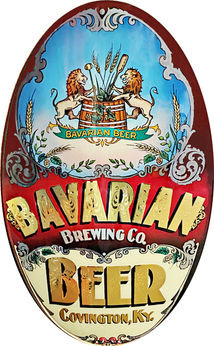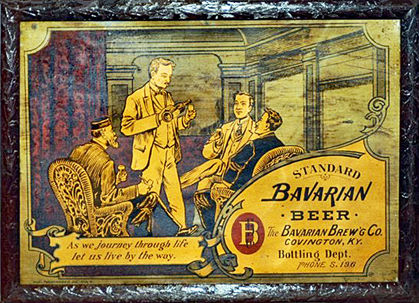
THE BEGINNINGS
- Of Bavarian Brewery
THE BEGINNINGS
- Of Bavarian Brewery
ADS - From Newspapers
SIGNS: BEFORE PROHIBITION
BEFORE PROHIBITION (Pre-Prohibition or Pre-Pro).
Signs that still remain for brewers and their beers before Prohibition and over a hundred years ago, i.e. before 1920, are relatively rare. The more common beer signs used in a saloon or tavern were often discarded once Prohibition started. However, there were some unique Pre-Pro signs made to be displayed on the brewery premises or in finer establishments. Even though few of these more unique signs were made, and some may have only one or two of a kind because they were so unique, they were sometimes retained by those associated with a brewery after Prohibition. Such signs are particularly coveted by collectors. Unfortunately, some of the Pre-Pro signs for the Bavarian Brewing Co. were only available from photographs.
MEYER RIEDLIN BREWING CO. c. 1884
After William Riedlin made an investment in the Bavarian Brewery in 1882 and became partners with John Meyer, the two decided to name the brewery after themselves in 1884. The sign on the side is one of two that were in an 1884 group photo of the brewery workers. It is not known whether these signs may still exist. It appears they were hand carved from wood. Of interest is that the sign references Bavarian Brewery, and Meyer & Riedlin's was a beer, not the name of the brewery. In addition, the symbols of the lions in the shield would later be used in the Bavarian Brewing Co. trademark, shown in the sign below.
BAVARIAN BREWING Co. c. 1890s
There was an early reverse glass painted corner sign made for Bavarian made in the 1890's by the Cincinnati Sand Blast Co. It had glue chip lettering, a zinc frame and probably a wood backing. Around 1900 it was hung in the Rathskeller and used for a group photo in 1902. It was also prominently displayed in the Bavarian Tap Room after Prohibition until the brewery closed in 1966. The image of this sign below left is from a professional black and white photo taken by the brewery and that is from the Schott Family Collection at the Behringer-Crawford Museum. Please see the Tap Room for photos of this sign as it was displayed. As depicted in the top of the sign, an image with two lions became part of the trademark for Bavarian. Above this image it appears there may have been some flaking on the sign. Even though a color photo of this sign was unavailable and the whereabouts of it are unknown, please see a similar sign for Kamm & Schellinger Brewing Co. also made by the Cincinnati Sand Blast Co. In addition, a sign that was restored that duplicates the noted Bavarian sign, possibly made by another company somewhat later, is shown in color and in a gold frame below - courtesy of David Green. The center of this sign was also enlarged on the far right. In comparing these two Bavarian signs, it appears that besides a difference in the width and style of the frames, there are some subtle variants in the designs and the lettering treatment for "Bavarian" and "Beer" is also different. These signs are highly prized and desired by collectors.
VITROLITE GLASS SIGN c. 1910
Vitrolite is pigmented glass that was used for signs and as a structural building material. It was made by the Meyercord Co. in Chicago, IL, beginning around 1907. This material came in different colors and was particularly popular from 1910 into the 1930s for panels on the exteriors of buildings during the Art Deco movement. Similar material was made by other companies, but it was generically called Vitrolite. Since it was easy to clean and reduced bacteria it was also used for interior treatments, e.g. table tops, counters, bathroom walls and partitions, wainscots, ceilings, etc. The signs helped promote the early introduction of Vitrolite before Prohibition and were usually made of milk glass with either a tubular metal or wood frame. Graphics were painted on the exterior of the signs and the glass could be flat or curved. They were typically used as outdoor corner signs, as many saloons were located on corners. These signs were occasionally made or modified so lighting could be inserted in the frame to illuminate the sign. Vitrolite signs were made for over two dozen different brewers, as well as other types of firms, e.g. distillers, cigar makers, dairies and others. They are extremely collectible.
FRAMED METAL SIGNS c. 1900
The first sign below is etched and colored on metal. The other image is from a professional black and professional photo taken by the brewery that is now part of the Schott Family Collection at the BC Museum. Unfortunately, a color photo was unavailable and the whereabouts of this sign are unknown. It shows an image with a clear beer bottle. Under Bottles, it is apparent that Bavarian Brewing Co. ordinarily used a brown embossed bottle before Prohibition. However, according to the sign, the brewer apparently also used a clear bottle for Standard Bavarian Beer. What's noteworthy in this sign, is that the label on the bottle is very similar to another depicted on this web site (see Beer Labels), but it has some differences. In comparison to one another, the label in the picture does not refer to Bavarian as a "Style" and has some other variations in its wording. Another observation, it appears the bottle cap at that time simply had a B before Prohibition. After Prohibition, the bottle caps required more information. (Please see Crowns.)

TIN OVER CARDBOARD SIGN c. 1900
It was common before Prohibition to create a sign in color made of tin, that had a backing of wood or cardboard. The sign shown is such an example. Unfortunately, the image was obtained from an unknown source and it is in very poor condition. Nevertheless, it provides an example of a colorful image and slogan that was used by the Bavarian Brewing Co. What may be different with this sign from those above, is that the holes in the sign indicate that it may have been intended to install directly on a wall, not framed.
MIRROR SIGN c. 1900
This sign below measures about 18 inches wide and was from the Cincinnati area. It has no other markings, but because of its origins, it is assumed to be from the Bavarian Brewing Co. in Covington, KY. Often saloons Pre-Prohibition had exclusive agreements to sell beer from only one brewery, or the saloon was located in a building owned by the brewery. This sign provided notice of the only type of beer the saloon served.








